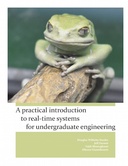Explore

A Practical Introduction to Real-time Systems for Undergraduate Engineering
6 Ungluers have
Faved this Work
Login to Fave
This course will begin by introducing the requirements and constraints of real-time and embedded systems, together with examples. Next, we will consider various programming paradigms, appropriate characteristics for embedded and real-time programming languages, and an introduction to the C programming language and contrast it with C++. We continue by describing the organization of a computer, including descriptions of Turing machines, register machines, main memory, processor architecture and operating systems. Continuing from here, we describe static memory allocation and the call stack, and then consider dynamic memory allocation, including numerous variable-sized-block strategies, their appropriateness for real-time systems and various implementations in FreeRTOS. We also consider automatic memory allocation, including garbage collection. Following this, we discuss the idea of threads and tasks running in parallel, looking at examples of sorting in parallel, and the data structures necessary to maintain threads. We then consider the issue of scheduling threads, first with multi-programming, non-preemptive scheduling and the concept of context switching, and then considering multitasking with preemptive scheduling, focusing on real-time schedulers such as earliest-deadline-first and rate- monotonic scheduling. Next, we consider the issue of the communication of other devices with the processor and the concept of interrupts and interrupt service routines as well as the impact of interrupts on real-time systems. Next we consider synchronization issues between cooperating threads and tasks, including issues of serialization and synchronization. We describe semaphores and consider a number of synchronization problems and consider solutions using semaphores. Additionally, we consider other means of automatic synchronization. With this, we consider the application of semaphores and synchronization in general to resource management, looking specifically at priority inversion. The most serious issue, however, is deadlock, when tasks and threads holding resources are mutually blocked on subsequent requests and how to avoid this issue. Next, inter-process communication is discussed together with how synchronization can be achieved through messaging. Next, we consider fault tolerance, specifically considering error detection and correction, the synchronization of clocks, and fault-tolerant message passing. Having considered all this, we now consider how resource management can be centralized in an operating system protected with fault tolerance through kernel modes and space. Having achieved this, we now consider the problem of software simulating including client-server models and distributions, and then software verification, including a look at propositional logic, predicate logic, linear temporal logic, computation tree logic and model checkers. We conclude the course by consider issues of data management and file management, virtual memory and caching, digital signal processing and digital control theory, and finishing with an introduction to security and a look at what is ahead.
Why read this book? Have your say.
You must be logged in to comment.
Rights Information
Are you the author or publisher of this work? If so, you can claim it as yours by registering as an Unglue.it rights holder.Downloads
This work has been downloaded 686 times via unglue.it ebook links.
- 686 - pdf (CC BY-NC-SA) at Internet Archive.
Keywords
- Computer engineering
- Engineering
- Nonfiction
- Systems engineering
Links
web: https://ece.uwaterloo.ca/~dwharder/icsrts/Lecture_materials/Editions

